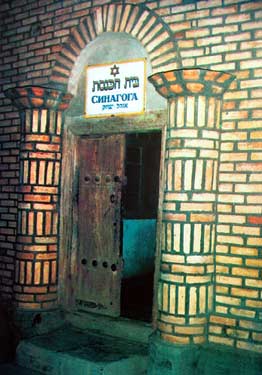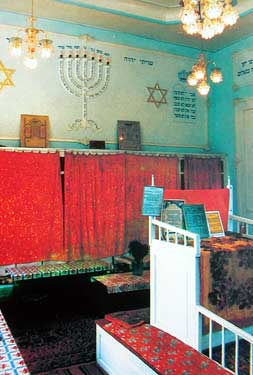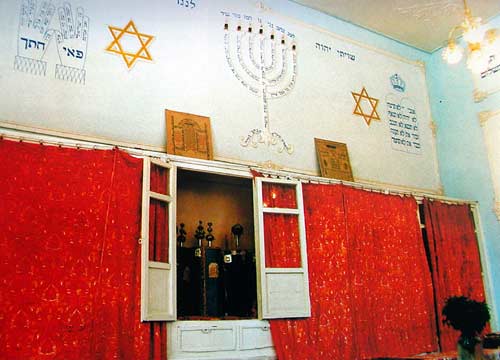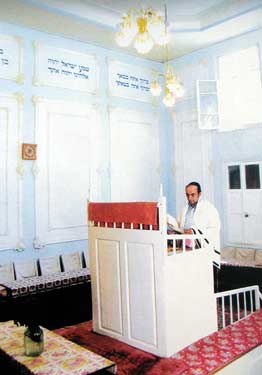|
Category
|
Synagogue in Bukhara
In the XVII century the most influential dignitary Nadir Divan-Begi, which accounted for his uncle Emir Imamkuli Khan, laid the foundation for the creation of an architectural complex of Labi-Hauz. Initially Nadir Divan-Begi built a large madrasa Hanaka, which still bears his name. Next to the madrassa was a large yard belonging to the Jew widow. Nadir Divan-Begi decided that the area occupied by the Jewish court, is very appropriate for the construction water reservoir (Hauz) at the mosque. He turned to her with a request that she sold her court at any price. But the Jew would never agree to sell it. Divan-Begi then took her to the Khan, being sure that he would order her to pay his court. But Imamkuli Khan gave consideration at the conclusion of Board of muftis. Having examined the case, Muslim jurists ruled that prohibits the court to take away the power of a Jewish woman, because, in their opinion, the Jews should enjoy the same rights as Muslims, because they pay tax "jizya", the right to preserve their religion. It should be clear that even the Caliph Umar forbade the destruction of the old synagogues that existed in Caliphate in the pre-Islamic period, but at the same time, banned and building new ones. There was even a case where Caliph Omar ordered to demolish the mosque, which had been illegally built on Jewish land. Jews, along with Christians and Zoroastrians, have autonomous control of the head, which was responsible for the payment of taxes from the community by the Muslim administration. Institute for autonomous control of the Jewish Diaspora was formed in the VIII century. The same structure was adopted in Samarkand in about 400 years old.
Divan-Begi agreed to the deal and handed over to the woman's own land, who was in the neighborhood, now known as "Jewish." Here the Jews were soon built the first synagogue, a Jewish court went on to Divan-Begi. This gave him the opportunity to expand the reservoir to the present size. The name of the widow did not survive in the memory of the people. It is said that she lived after the construction of a synagogue in its upper floor, and by will, after her death, this floor was destroyed, but instead built a room next to the synagogue, which also served as a prayer room for Jews.
The pond, hosted by Nadir Divan-Begi, now known under the name Labi-Hauz. Approximate date of construction - 1620. Interestingly, before the construction of the first Synagogue Jews prayed in the same room with the Muslims in a mosque called "Magoki Attari", otherwise known as "The Mosque in the pit" or "Deep mosque." According to one version, the Jews prayed with the Muslims in the same time but at different angles. According to another - the Jews came back only after the Muslim prayers. This may explain the tradition that exists in the Bukharian Jews, finishing the morning prayer with the words "Shalom Aleichem" ("Peace be upon you"), which is absent in the European Jews.
According to another version, the Jews live in the present Mahalla (quarter) from the time of their resettlement from Persia. It is said that the area was occupied by Muslims, and when he deserted, located here quarters were destroyed, and the ruler of Bukhara gave the place the Jews who came from Jerusalem in the interests of trade. Jewish Synagogue in Mahalla having 300 years history, was closed by Soviet authorities in 1940. It was only in 1945, the insistent request of the population, the Jewish community was returned to the old Synagogue, which operates to this day. Source: D. Paige. Bukhara. Guide to the architectural and historical sights |
 About Bukhara, about this wonderful city, there are many legends, tales and stories about his old “Guzars” (quarters), architectural ensembles and monuments, residents, sheikhs, dervishes and rulers.
About Bukhara, about this wonderful city, there are many legends, tales and stories about his old “Guzars” (quarters), architectural ensembles and monuments, residents, sheikhs, dervishes and rulers. Thus, the Nadir Divan-Begi had to limit the device small pond adjacent to the house where she lived a widow intractable. Friends also advised him to spend a small canal that carries water from the Shohrud channel to the pond, in a roundabout way, and so he went under the house of a widow. This is a smart way, in their opinion, should soften the stubbornness of a woman. Divan-Begi followed the advice of friends, and lost no time, he did what he advised, despite the fact that it was more expensive. After a while, when the water began to wash away the foundation of the house, turned to the Jewish Nadir Divan-Begi for justice. To which he replied that his proposal is still in force, and he now pays the cost of the house, only that it has agreed to sell it. However, the widow explained that she did not need the money, since she lives alone and has no heirs. But she promises that if you return her to her court will give a plot of land to build a Jewish synagogue, she promises that she will give Divan-Begi their possessions.
Thus, the Nadir Divan-Begi had to limit the device small pond adjacent to the house where she lived a widow intractable. Friends also advised him to spend a small canal that carries water from the Shohrud channel to the pond, in a roundabout way, and so he went under the house of a widow. This is a smart way, in their opinion, should soften the stubbornness of a woman. Divan-Begi followed the advice of friends, and lost no time, he did what he advised, despite the fact that it was more expensive. After a while, when the water began to wash away the foundation of the house, turned to the Jewish Nadir Divan-Begi for justice. To which he replied that his proposal is still in force, and he now pays the cost of the house, only that it has agreed to sell it. However, the widow explained that she did not need the money, since she lives alone and has no heirs. But she promises that if you return her to her court will give a plot of land to build a Jewish synagogue, she promises that she will give Divan-Begi their possessions. The oldest part of the synagogue was known as "Kanisa Mulla Mani" that is, the synagogue named Mullah Mani - the so-called respectable Jew, who was foreman in the synagogue.
The oldest part of the synagogue was known as "Kanisa Mulla Mani" that is, the synagogue named Mullah Mani - the so-called respectable Jew, who was foreman in the synagogue. There is a version that resettlement of Jews in the Jewish quarter is associated with the construction of the Synagogue. Jews to build synagogues lived near present Labi Hauz, on a site called "Bozori Jaw," that is "Barley Market". In an effort to concentrate around the house of worship, they gradually moved into the quarter, which was built a synagogue, so that at the Barley market there is not a single Jewish family.
There is a version that resettlement of Jews in the Jewish quarter is associated with the construction of the Synagogue. Jews to build synagogues lived near present Labi Hauz, on a site called "Bozori Jaw," that is "Barley Market". In an effort to concentrate around the house of worship, they gradually moved into the quarter, which was built a synagogue, so that at the Barley market there is not a single Jewish family.














